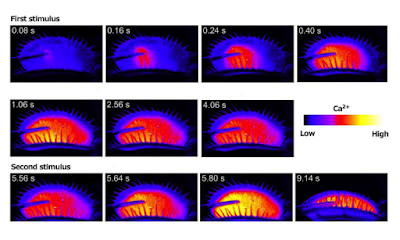Posted by Sondra Broomell
Venus Flytraps are one of the very plant species that are carnivorous and exhibit movement. It is thought that this evolutionary adaptation came about in response to life in areas with little nutrition. When triggered, the plant snaps shut, digests, and absorbs nutrients from their visiting prey. However, the response is a bit complex, for a plant. For the “mouth” lobes to shut, the prey must brush, push, or somehow agitate trigger hairs located on the lobes twice, in quick succession (within 30 seconds). This double trip adaptation is believed to keep the plant from wasting energy by snapping shut on something that causes only a momentary disturbance, such as a raindrop or wind. Scientists have been studying the Venus flytrap for some time in hope of discovering the evolution of movement and carnivory in plants as well as discovering how the plant remembers how many times its sensory hair was triggered without a nervous system. In 1988 a group of scientists conducted a study utilizing freeze-fracture studies and microelectrode measurements to determine the action potential of the Venus Flytrap movement. Through a series of experiments, the researchers measured action potentials generated by several different ions. They suspected that two overlapping spikes in intracellular calcium ions were required for the plant to snap shut. Calcium ions are known to convey information between cells but without the technology to measure extracellular and intracellular calcium concentration, their findings were limited. But for the first time Japanese researchers were able to visualize, through fluorescence, the calcium ions required for the Venus Flytrap to shut. A recent article on The New York Times website summarizes the study published in Nature Plants. With gene splicing technology, the researchers introduced a fluorescent protein gene to the Venus Flytrap by infecting the leaves with a modified bacteria which were then used to grow new plants containing the fluorescent gene. This protein, GCaMP6, only fluoresces when bound to its target, calcium ions, enabling visualization of calcium ion movement into the cell. Once the plants matured, all that was left was to trigger the sensory hairs of the Flytraps and watch them glow. After a single disturbance of the trigger hair, the fluorescence began at the base of the trigger hair and spread across the leaves. After a second disturbance of the trigger hair within 30 seconds, a second surge of intracellular calcium ions caused the lobes glow brighter, and the concentration reached the threshold to trigger an action potential that caused the plant to snap shut. When the second trip happened after 30 seconds, enough calcium ions diffused out of the cell to prevent the concentration from reaching the threshold for movement. Visualizing ionic movement through a plant by means of fluorescence is sure to be spectacular, but also puts up a step closer to understanding the mechanism behind plant movement.
Figures from PhysOrg



This is a lovely story. The beauty of it is that it emphasizes the chemistry of the strange biological behavior by focusing on the clever chemical probe used to follow the chemical steps that lead to the triggering of the closing of the trap. You summarize the source well in your own words. I love the title. It would certainly attract attention. You have chosen effective graphics. Graphic captions might help although they are fairly self explanatory.
ReplyDelete